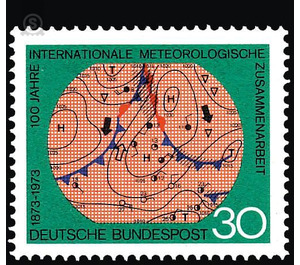100 Years of international metrological cooperation - Germany / Federal Republic of Germany 1973 - 30 Pfennig
Theme: Expeditions & voyages
| Country | Germany / Federal Republic of Germany |
| Issue Date | 1973 |
| Face Value | 30.00 |
| Color | green |
| Perforation | K 14 |
| Printing Type | Multicolor offset printing |
| Stamp Type | Postage stamp |
| Item Type | Stamp |
| Chronological Issue Number | 649 |
| Chronological Chapter | GER-BRD |
| SID | 782165 |
| In 41 Wishlists | |
Regular meteorological observations and measurements date back to the 17th century. Already in the 18th century they were used for studies on the climate of different regions. However, the real upswing in meteorology began in the middle of the 19th century after the invention of the telegraph. Many researchers realized that regular, rapid exchange of meteorological observations would make it possible to track and predict the weather from day to day over a large area. However, such an objective could not be achieved without close international cooperation. After a series of private contacts between European scientists, the first International Meteorological Congress was held in 1873. This congress, which was attended by representatives from 18 countries, established the International Meteorological Organization (IMO) and initiated a rapidly increasing meteorological cooperation. This was z. For example, it is possible that meteorological observation networks are built according to uniform conditions, uniform measuring methods are used and weather reports are exchanged in globally understandable numerical keys and that weather maps are in use that can be interpreted in the same way all over the world. In addition, impetus was given for the application of meteorological knowledge to aviation, shipping, agriculture and other economic sectors, and meteorological research was coordinated. A first example of this was the International Polar Year 1882/83. The IMO merged in 1950 into the World Organization for Meteorology (WMO), which was founded as a United Nations Special Organization. The WMO now includes 123 states and 13 so-called territories (areas without state properties, but with their own weather services). The WMO will honor the 100th anniversary of the meteorological organization IMO / WMO with festive events in September 1973 in Vienna and Geneva. The stamp shows a section of a working weather map of the German Weather Service. In detail, print formations, front systems with precipitation zones and weather symbols are shown.


